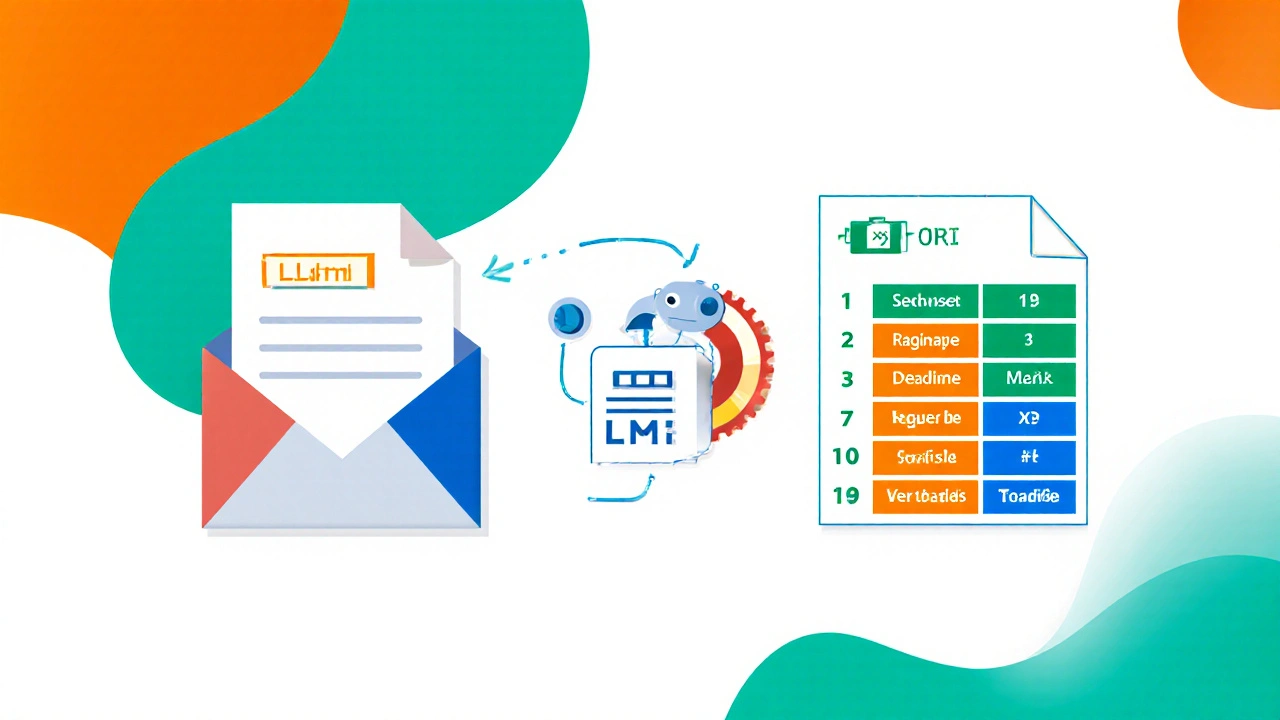AI Automation Workflow Builder
Create Your AI Workflow
AI Technologies Used
Large Language Models (LLMs)
Powerful text generation and parsing capabilities.
GPT-4, Claude, GeminiPrompt Engineering
Crafting precise prompts for desired outputs.
JSON formatting, instruction clarityWorkflow Orchestration
Connecting steps to automate end-to-end processes.
Zapier, Make.com, Power AutomateData Extraction
Parsing structured data from unstructured inputs.
JSON, CSV, XMLBusinesses and developers keep asking how to make processes run without a hitch. The answer lies in blending clever AI tricks with modern automation platforms. In this guide you’ll see why AI automation is the next leap forward, which technologies actually deliver, and how to stitch them together for friction‑free workflows.
Key Takeaways
- AI tricks like prompt engineering and low‑code model integration turn ordinary bots into smart assistants.
- Core AI tech-large language models, computer vision, and NLP-each solves a specific automation problem.
- A step‑by‑step recipe shows how to build an email‑to‑sheet workflow that categorizes requests automatically.
- Comparison of the leading AI‑enabled automation platforms helps you pick the right tool for your budget and skill level.
- Best‑practice checklist avoids common traps such as data leakage, model drift, and over‑automation.
What Are AI Tricks in Automation?
Before diving into tools, let’s define the core concepts. Artificial Intelligence is a branch of computer science that creates systems capable of performing tasks that normally require human intelligence, such as understanding language or recognizing images. When AI powers Automation it means repetitive or rule‑based processes are executed without manual intervention, often at a speed and scale humans can’t match.
‘AI tricks’ are the practical techniques-prompt engineering, low‑code model embedding, or chaining multiple AI services-that let you extract maximum value from these technologies without building a full data‑science pipeline.
Core AI Technologies That Enable Seamless Automation
Large Language Models (LLMs) are deep‑learning systems trained on massive text corpora. They generate human‑like responses, summarize documents, and can extract structured data from unstructured text. Popular examples include GPT‑4, Claude, and Gemini.
Prompt Engineering is the art of crafting input queries that guide LLMs to produce the exact format you need-tables, JSON, or short answers-while minimizing hallucinations.
Computer Vision lets machines interpret images and video. APIs like Vision AI or Azure Computer Vision can read invoices, detect defects on a production line, or verify identity documents.
Natural Language Processing (NLP) covers tasks such as sentiment analysis, entity recognition, and language translation. NLP engines power chatbots, ticket routing, and real‑time language monitoring.
Robotic Process Automation (RPA) mimics user actions on graphical interfaces. When combined with AI, RPA can handle exceptions that pure rule‑based bots miss.
Workflow Orchestration platforms (e.g., Apache Airflow, n8n) schedule and connect multiple AI services, ensuring data flows smoothly from one step to the next.
Real‑World AI Automation Use Cases
1. Intelligent Email Triage - An LLM reads incoming support emails, classifies urgency, extracts key details, and creates a ticket in the CRM. The system also drafts a brief acknowledgment reply.
2. Invoice Processing - Computer vision reads scanned invoices, extracts line items, and feeds them into an ERP system. An RPA bot verifies totals and flags mismatches for human review.
3. Customer‑Facing Chatbots - A AI‑powered Chatbot uses LLMs to answer product questions, suggest alternatives, and hand off complex cases to agents.
4. Predictive Maintenance - Sensor data is fed into a time‑series model that predicts equipment failures. The workflow automatically schedules a service order before downtime occurs.
These examples show how AI tricks turn basic automation into truly smart, context‑aware processes.

Step‑by‑Step: Build a Simple AI‑Powered Email‑to‑Sheet Workflow
- Trigger: New Gmail Message - Use a low‑code platform (Zapier, Make.com, or Power Automate) to watch a dedicated inbox.
- Extract Content - Pass the email body to an LLM via the provider’s API. Prompt: “Extract the request type, deadline, and any attached file names. Return JSON.”
- Parse JSON - The platform parses the LLM response and maps fields to columns.
- Store in Google Sheets - Append a new row with the extracted data.
- Notify Team - Send a Slack message with a link to the new row and a summary generated by the LLM.
- Handle Errors - If the LLM returns an error, route the email to a “Manual Review” folder and alert a manager.
This workflow runs in seconds, requires no code beyond the visual builder, and demonstrates three AI tricks: prompt engineering, JSON extraction, and conditional routing.
Tool & Platform Comparison
| Platform | AI Capabilities | Integrations | Pricing (Base Tier) | Ease of Use |
|---|---|---|---|---|
| Zapier AI | LLM text generation, sentiment analysis | 5,000+ apps | $29/mo | Very high - drag‑and‑drop |
| Microsoft Power Automate | LLM, OCR, computer vision (Azure AI) | 3,000+ connectors | $15/mo per user | High - Microsoft ecosystem |
| UiPath AI Center | Custom model hosting, RPA + AI | 200+ native apps, custom APIs | $99/mo (team) | Medium - requires scripting |
| Make.com (formerly Integromat) | LLM plug‑ins, vision API | 1,000+ services | $20/mo | High - visual scenario builder |
Pick a platform that matches your team’s technical comfort and budget. For quick prototypes, Zapier AI or Make.com are ideal. For enterprise‑scale, Power Automate and UiPath give tighter security and governance.
Best Practices & Common Pitfalls
- Start with a clear data contract. Define the exact JSON schema you expect from LLMs; this avoids downstream parsing errors.
- Guard against hallucinations. Validate AI output against known rules (e.g., total sum must equal invoice amount) before committing to downstream systems.
- Monitor model drift. Schedule periodic re‑evaluation of prompts and model performance, especially if input language evolves.
- Secure sensitive data. Use encrypted storage and ensure AI providers comply with GDPR, CCPA, or local regulations.
- Avoid over‑automation. Keep a manual override for high‑risk decisions; an automated system should augment, not replace, critical human judgment.
Next Steps & Troubleshooting
If your workflow stalls at the LLM step, check API rate limits and verify that the prompt follows the exact format used in the successful test case. For integration errors, examine the platform’s error logs-most tools highlight the offending field in red.
When scaling, consider moving from a hosted LLM to a self‑managed model (e.g., Llama3 or Mistral) to control costs and data residency.
Frequently Asked Questions
Can I use free LLM APIs for production automation?
Free tiers are great for prototyping, but they often have strict rate limits, no SLA, and limited data retention guarantees. For any mission‑critical workflow you should upgrade to a paid plan or self‑host a model to ensure reliability.
How do I keep AI‑generated data secure?
Encrypt data at rest and in transit, use API keys with least‑privilege scopes, and choose AI providers that are compliant with regional privacy laws. Also, avoid sending personally identifiable information to third‑party LLMs unless you have a contractual data‑processing agreement.
What is the difference between RPA and AI‑driven automation?
RPA mimics human clicks and keystrokes based on static rules. AI‑driven automation adds perception (vision, language) and decision‑making, allowing the system to handle unstructured inputs and adapt to new scenarios without re‑programming every rule.
Do I need a data‑science background to use these AI tricks?
No. Most platforms expose AI as simple API calls or pre‑built modules. Understanding how to phrase prompts and how to validate output is enough for many automation scenarios.
How often should I revisit my automation workflows?
Schedule a quarterly review to check for prompt drift, integration changes, and cost spikes. If you notice a drop in accuracy or a new feature from your AI provider, update the workflow promptly.

